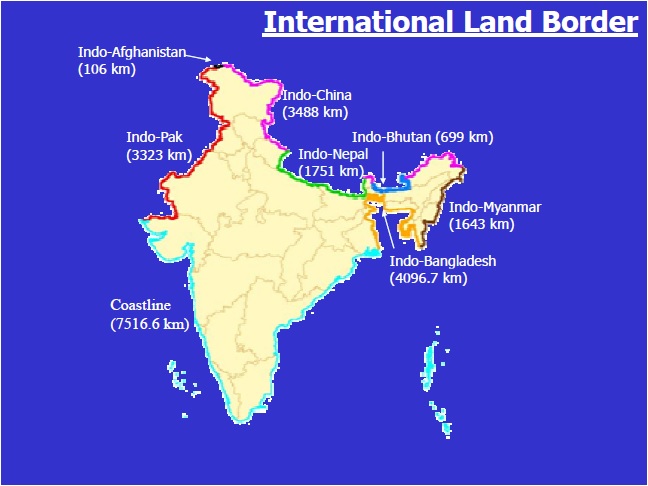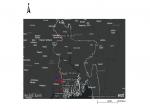Genesis
The Indian Independence Act of 1947 was finally put in execution on 18 July 1947 giving out the broad details of the partition of British India into the two dominions of India and Pakistan, based on Hindu and Muslim majorities respectively[1]. This was a United Kingdom Act of Parliament which was to be effective with effect from 15 Aug 1947[2]. In the process, when the Radcliffe line was drawn as a border between India and Pakistan intensifying the miseries for human life, people died in large numbers[3] during the partition. It was a manmade disaster of an unprecedented level, never seen in the world.
While India grappled with its initial challenges of integrating the various princely states, chiefly the accession of J&K, and integration of Goa and Hyderabad, the border on the Western front in the state of J&K currently exists in the form of the Line of Control (LC) as Pakistan occupied Kashmir (PoK) is currently under physical occupation of Pakistan. Not only this, Pakistan ceded Shaksgam valley to China in 1963[4]. The border with China and large tracts of land are under the possession of China predominantly in Aksai Chin and are disputed by India[5]. The boundary with China is currently in the form of the Line of Actual Control (LAC) which has also been transgressed at several locations in Eastern Ladakh besides in several other areas along the LAC with disputes based on differing perceptions of the same line[6].
Due to these factors, the borders' length and management keep getting refined. India currently has more than 15000 km of land borders and more than 7500 km of maritime borders[7]. It shares borders with seven countries including Afghanistan, Pakistan, China, Nepal, Bhutan, Bangladesh and Myanmar. Border guarding responsibility initially was with the state forces post-independence, however, the same was found inadequate to handle the challenges and threats[8]. Based on the inadequacies experienced paramilitary forces (PMFs), now called central armed police forces (CAPFs) were raised under the Ministry of Home Affairs (MHA) and were tasked to guard the borders under the control of the ministry. In case of active hostilities, the Army is given the responsibility to man the borders. CAPFs responsible for the border guarding role are invariably placed under the operational control of the Army in such cases as an integrated approach becomes critical for success.
All our borders are currently being guarded with different models with no single force being responsible exclusively for border guarding. Post-Kargil conflict, one of the recommendations was to earmark one type of force for one country[9]. After a lot of resistance, initial hitches and reorganization, border guarding responsibilities have been allotted to the following forces-

The salient aspects of these borders, their management, challenges and opportunities have been covered in succeeding paras.
Pakistan
The border with Pakistan has been a problematic one since India’s independence. Despite the accession of Jammu and Kashmir (J&K) to India as per the Indian Independence Act of 1947, Pakistan fought four conventional wars with India namely in 1947-48, 1965, 1971 and 1999. It has also been engaged in a proxy war as well both in the state of J&K and Punjab. It is already in adverse possession of PoK, an Indian territory and continues doing so even today. The border is active in form of LC where the Army has been deployed in addition to the BSF. A border fence, also called the anti-infiltration obstacle system (AIOS) has been created[10].
The notion of border guarding forces has to move beyond policing actions. These organizations should be so structured that a common equipment profile, war-fighting tactics and logistic module emerges which can be leveraged both during peace and war. Capability creation in BSF almost at par with the Indian Army is critical along with the Jammu and Kashmir Police (JKP) in the depth, which can relieve the Indian Army for offensive tasks as well as realigning its focus on the Chinese threat which has a higher probability of escalation.
Due to the border fence, large tracts of Indian territory have been left out between the zero line and the AIOS. There is restricted usage of this land for the farmers due to a fragile peace, besides putting additional strain on the BSF to manage the gates for moving in and out of the farmers. The border fence must be shifted westwards and fixed on the zero line, which will not only result in claiming the land realistically but will make border management more effective. A national land boundary law should be passed by the Indian parliament wherein firing/intrusion along the border should be declared as an act of war followed by a well-crafted military response.
Bangladesh
Part of erstwhile Pakistan and initially called East Pakistan, Bangladesh was liberated with Indian assistance to become an independent nation in 1971. The relations between India and Bangladesh have been moving up and down based on the government in power. While Pakistan and China constitute two fronts for India, Bangladesh had gravitated towards becoming another half-front before the current Government of Bangladesh assumed power. The current relations with Bangladesh are very good but Pakistani efforts to create a religious divide, Chinese inroads and presence of inimical elements have made the peace process prone to disruption[11].
BSF should endeavour to shift the border fence on the zero line as recommended for the Pakistan border. Due to the friendly government in Bangladesh and having displayed a large heart in border settlement as per the 2015 act, it should be possible to shift the fence appropriately on the zero line enhancing the border sanctity further. There has been a substantial population migration in the border-states of India from Bangladesh and population inversion has taken place in certain areas[12]. Our policy has neither been clear nor progressive. There is a definite need to allow some kind of card for migrants who may be keen to work in India. This should have no voting linkage and an effective regulatory mechanism must exist on the lines of USA/European countries. It will be in the Indian interest if salients of Bangladesh jutting into the Siliguri corridor[13] are handed over to India and India can offer equal area in other border areas based on mutual agreement. It will reduce the strain on BSF, both during peace and war, as a shortened border length will reduce the commitments of border guarding forces besides offering requisite depth to the Siliguri Corridor.
China
The most complex and longest border that too in the form of LAC enmeshed with areas of differing perception at multiple locations is with China. The ITBP is responsible for Chinese border management. The name Indo-Tibetan Border Police is fully apt as India needs to see this border as that between India and Tibet as against the border between India and China. Leveraging the Tibetan Government-in-exile for a border agreement is a strategic option which India needs to leverage in the overall national interest. The current structure of ITBP, its equipping and tactical doctrine is not fully oriented to handle the Chinese threat. The structure, equipping, training and operational philosophy must be in tune with the Indian Army to leverage its full potential. An adequate number of battalions should be raised to meet the border guarding requirements all across the LAC. An endeavour should be made to undertake effective deployment of ITBP on this front. The quantum of deployment will increase substantially as the LAC is moving in the direction of LC and will consume a substantial number of troops on a sustained basis. The high-altitude areas will demand a higher degree of physical and mental robustness. It may necessitate certain changes in the human resource (HR) policy to ensure the necessity of a younger age profile. It will not be an exaggeration to say that the entire HR policy of the Indian Army as well as the border guarding forces should be the same, especially on the Pakistan and China border to say the least. China's challenge is real and therefore the entire gamut of border guarding needs to be given a fresh look as capacity creation takes time. It will be for the inclusion of Tibetans staying in India to also become part of this deliberation to leverage the Tibetan issue to the max extent possible.
Nepal
SSB is now responsible for the Nepalese border. Due to close relations between India and Nepal, Nepalese working in the Indian Army as soldiers and porous border, border management remains a challenge. In fact, except for the vehicles, there is no check whatsoever on the population of both sides to move across while moving on foot. Chinese inroads are making their impact on Nepal. Several Chinese activities in terms of infrastructure development and language centers have come up in Southern Nepal close to Indian borders[14]. Without adding to the inconvenience of the common people, more modern means have to be adopted for border guarding as the porous border is being used by Indian fugitives to move to Nepal and thereafter to other parts of the world. Pakistan’s ISI is also using the porous nature of this border to infiltrate militants for anti-national activities in India. India should also engage with Nepal to make it not only realize the Chinese threat but also resolve geographic borders or previous treaties. The current border guarding /surveillance is essential to take care of our national interest.
Bhutan
In addition to Nepal, the SSB is also responsible for Bhutan's borders. The border is relatively open all along. India is also responsible for the defence of Bhutan and therefore responds to Chinese aggression even in Bhutan which happened in Doklam in 2017[15]. The border differences have been resolved after mutual consultations over a period with finality reached in 2006. The border is relatively tranquil despite being porous and disturbing elements have been eliminated due to joint India-Bhutan operations close to the Indian border but in Bhutanese territory. Since the Chinese threat manifesting through Bhutan always remains, it will be more appropriate to give the responsibility of the Bhutan border to BSF whereas, in turn, SSB can be given the responsibility of the Bangladesh border. This change will be more aligned with futuristic threats.
Myanmar
India and Myanmar share a large land boundary with the northern end bordering China and the southern end bordering Bangladesh. As per Govt policy of one country, one border guarding force, Assam Rifles is responsible for the border guards. The border remains porous as local communities are divided into both sides of the border. The current arrangement also allows insurgents to have camps in the dense jungles of Myanmar across the border. While some operations have been conducted by India with the cooperation of the Myanmar government, the insurgents keep operating from across the border. A recent change in Myanmar and the taking over of the country by the military has created multiple challenges. There are a large number of refugees moving into the northeastern (NE) states, primarily in Manipur[16]. The Manipur government is sympathetic towards them due to their common lineage amongst them[17]. This is despite the Central government’s policy of not accommodating them. A historical analysis needs to be done to understand why the Britishers gave it a separate and independent status in 1937[18]; otherwise, it would have been part of India on 15 Aug 1947. Who knows the dynamics of the country would have been different and better integration in the North East would have been done immediately after Independence.
Summary
India has borders with seven countries and with the current approach all borders are being guarded with one country-one border approach. 108 km of Afghanistan will also become a physical border once PoK becomes part of India as the entire state of J&K belongs to India as part of the accession instrument signed. Certain changes in the allocation of border guarding forces are essential based on external threats. Such a swapping between Bhutan and Bangladesh will be advantageous. Not only this, there is a serious need to reorganize, re-equip and re-task these border guarding forces to optimize their capabilities. The earlier it is done, the better it would be.
Endnotes :
[1]1947 Indian Independence Act - UK parliament - parliament of the United ... (no date) UK Parliament. Available at: https://www.parliament.uk/about/living-heritage/evolutionofparliament/legislativescrutiny/parliament-and-empire/collections1/collections2/1947-indian-independence-act/ (Accessed: September 20, 2022).
[2]Ibid.
[3]Dalrymple, W. (2015) “The Great Divide,” The New Yorker Magazine, 29 June.
[4]Chinoy, S.R. (2020) “The forgotten fact of China-Occupied Kashmir,” The Hindu [Preprint].
[5]Dutta, P.K. (2020) How China captured Aksai Chin, India Today. India Today. Available at: https://www.indiatoday.in/india/story/how-china-captured-aksai-chin-1691562-2020-06-22 (Accessed: October 20, 2022).
[6]Singh, S. (2020) Big Surge in Chinese transgressions, most of them in Ladakh, The Indian Express. Available at: https://indianexpress.com/article/india/aksai-chin-army-big-surge-in-chinese-transgressions-most-of-them-in-ladakh-6421674/ (Accessed: September 30, 2022).
[7]GatewayHouse (2018) Arc of India's border security, Gateway House. Available at: https://www.gatewayhouse.in/arc-indias-border-security/#:~:text=India's%2015%2C000%2Dkm%20borders%20touch,align%20neatly%20with%20political%20borders. (Accessed: October 2, 2022).
[8]Chopra, S. (2022) Don't reduce BSF from first-class border guarding force to third-class police force in states, ThePrint. Available at: https://theprint.in/opinion/dont-reduce-bsf-from-first-class-border-guarding-force-to-third-class-police-force-in-states/948730/ (Accessed: October 11, 2022).
[9]Gokhale, N. (2022) One border one force?,https://www.outlookindia.com/. Available at: https://www.outlookindia.com/website/story/one-border-one-force/221456 (Accessed: October 18, 2022).
[10]Mir, A. (2021) Anti-infiltration obstacle system regularly upgraded along Loc: Defence Ministry, The Kashmir Walla. Available at: https://thekashmirwalla.com/anti-infiltration-obstacle-system-regularly-upgraded-along-loc-defence-ministry/ (Accessed: September 10, 2022).
[11]Murtaza, N. (2022) Opinion: The reasons why Pakistan turned out different from India and Bangladesh, Scroll.in. Scroll.in. Available at: https://scroll.in/article/1030083/opinion-the-reasons-why-pakistan-turned-out-different-from-india-and-bangladesh (Accessed: October 13, 2022).
[12]Kapoor, B.A. (2021) Demographic invasion of India from the North East, Indian Defence Review. Available at: http://www.indiandefencereview.com/news/demographic-invasion-of-india-from-the-north-east/ (Accessed: October 20, 2022).
[13]Singh, M.P. (2019) What if China wrings India's 'Chicken's neck' – the Siliguri Corridor? here are some countermeasures, USI. Available at: https://usiofindia.org/publication/news/what-if-china-wrings-indias-chickens-neck-the-siliguri-corridor-here-are-some-countermeasures/ (Accessed: August 20, 2022).
[14]Sigdel, A. (2018) China's growing footprint in Nepal: Challenges and opportunities for India, ORF. Available at: https://www.orfonline.org/research/chinas-growing-footprint-in-nepal-challenges-and-opportunities-for-india/ (Accessed: September 3, 2022).
[15]Doklam fresh on mind, India promises Rs 4,500 crore to Bhutan: India News - Times of India (2018) The Times of India. TOI. Available at: https://timesofindia.indiatimes.com/india/doklam-fresh-on-mind-india-promises-rs-4500-crore-to-bhutan/articleshow/67294074.cms (Accessed: October 20, 2022).
[16]Matharu, S. (2022) 'they're taking over our hills': Manipur groups want NRC to weed out Myanmar refugees, The Print. Available at: https://theprint.in/features/theyre-taking-over-our-hills-manipur-groups-want-nrc-to-weed-out-myanmar-refugees/1002227/ (Accessed: October 20, 2022).
[17]Ibid
[18]Pillalamarri, A. (2017) When Burma was still part of British India, The Diplomat. for The Diplomat. Available at: https://thediplomat.com/2017/10/when-burma-was-still-part-of-british-india/ (Accessed: October 20, 2022).
(The paper is the author’s individual scholastic articulation. The author certifies that the article/paper is original in content, unpublished and it has not been submitted for publication/web upload elsewhere, and that the facts and figures quoted are duly referenced, as needed, and are believed to be correct). (The paper does not necessarily represent the organisational stance... More >>
Image Source: chrome-extension://efaidnbmnnnibpcajpcglclefindmkaj/https://www.mha.gov.in/sites/default/files/BMIntro-1011.pdf










Post new comment